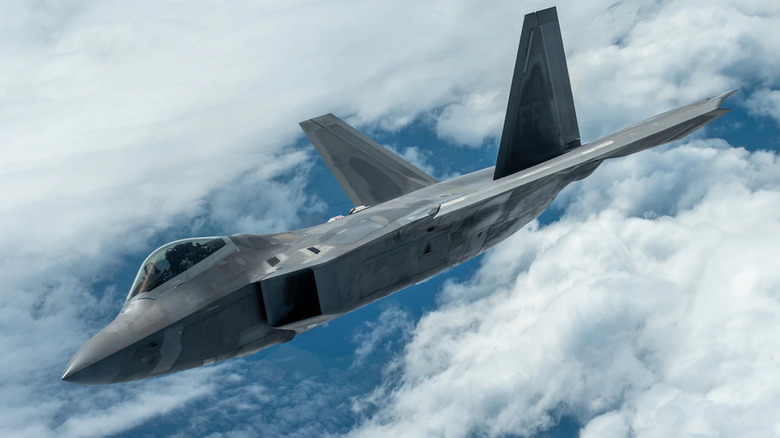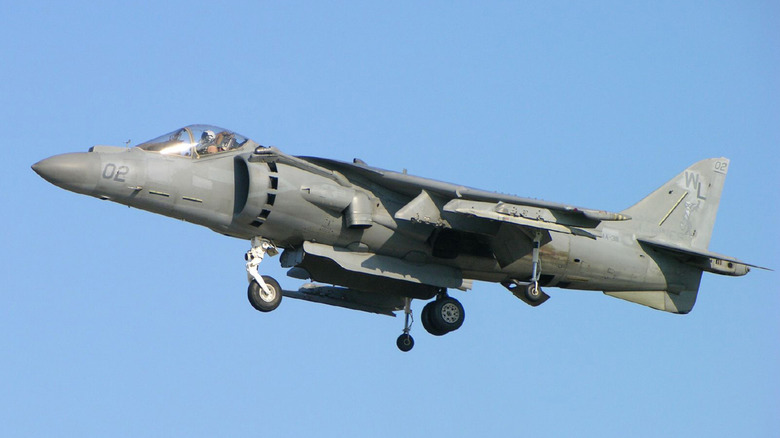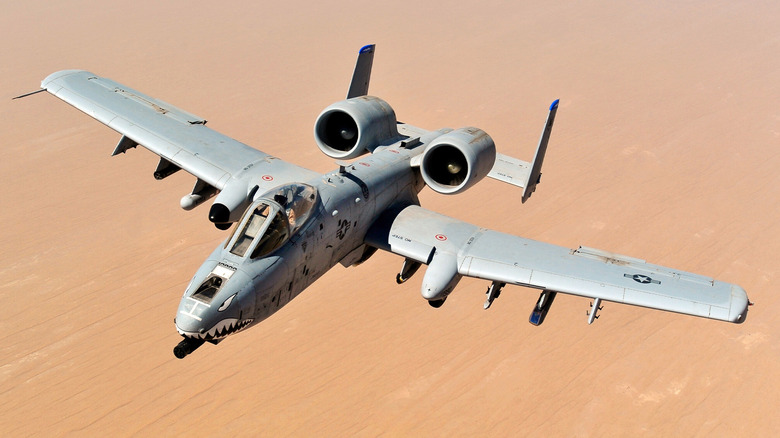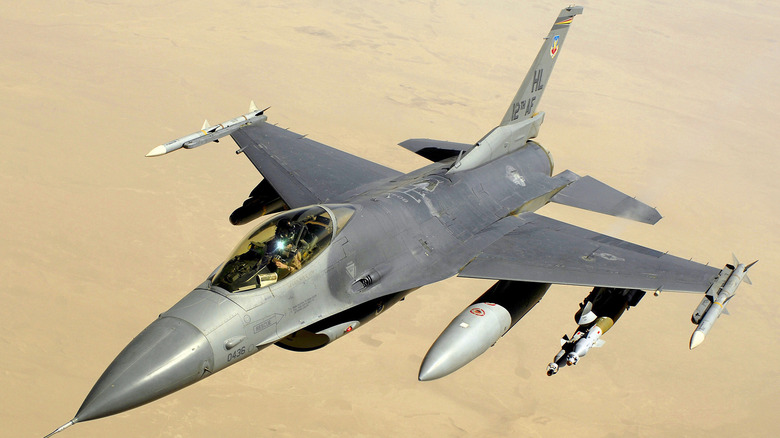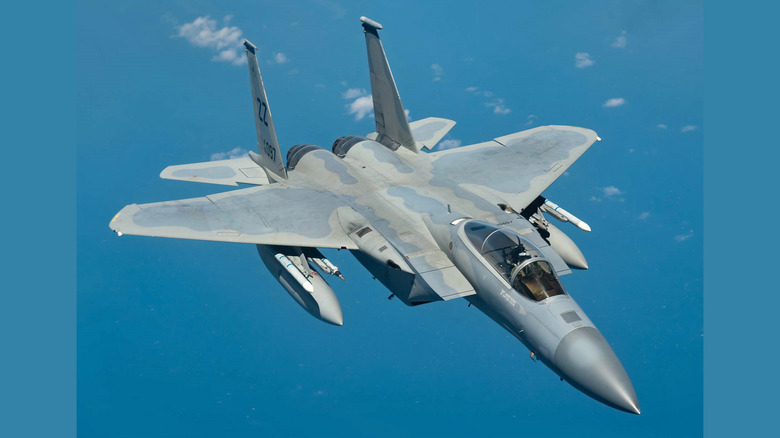5 Legendary US Fighter Jets That Are Being Retired In The Next 5 Years
Militaries all around the world have a habit of hanging onto their aircraft for as long as possible. It isn't a surprise considering how much military aircraft cost. In any case, this means that two things are true. The first is that retiring an aircraft from service is an uncommon event. There are 1970s fighter jets still in service today, so it's clearly not something the U.S. military does often. Secondly, when an aircraft finally does get to retire, it's usually a pretty big deal.
The reason for this is mostly due to utility. As long as the U.S. military can make use of something, the organization will typically find a reason to keep it around. Look at the Boeing CH-47 Chinook. The U.S. started using that chopper in the 1960s, and they still use it to this day, over 60 years later. However, as fighter jets and helicopters age, they start to become obsolete, and newer models swoop in (pun intended) to take their place.
However, the introduction of new aircraft can take many years, so even if a fighter jet is slated for retirement, it may still hang around for many years until the phase-out is complete. If you're curious about which U.S. fighter jets are on their way out the door, the list below are jets that are either set to finish their retirement or begin their retirement over the next five years.
AV-8B Harrier II and F/A-18 Hornet
The AV-8B Harrier II and F/A-18 Hornet fighter jets are both expected to begin their retirements soon. According to reports, the Harrier II is expected to retire in 2027, while the F/A-18 Hornet is expected to begin phasing out in 2030. The reason we're listing these two together is that both of these aircraft are being replaced in the Marine Corps' lineup by the F-35B Lightning II Joint Strike Fighter. The reason is fairly simple. The F-35B does what the Harrier II and Hornet do, but better.
The U.S. military began using the AV-8B Harrier II jet in 1981. Its hallmark feature was its vertical and short take-off and landing capabilities, making it an excellent choice for aircraft carriers, places with short airstrips, and even smaller amphibious vessels where regular fighter jets wouldn't work. In terms of duty, the Harrier II has been used everywhere from air-to-air, air-to-surface, and support missions. The F/A-18 Hornet was similarly versatile, being designed for air-to-air and surface-to-air combat. It began life in the 1970s as the YF-16 and YF-17 prototypes. The military eventually went with the F-16 to replace the F-4 and A-7, which is likely why it has the unique F/A designation.
The U.S. military may be finishing with them in the near future, but both fighters are still used in other countries. The Harrier II is used in Spain and Italy, while the F/A-16 is still used by the Royal Australian Air Force.
Fairchild Republic A-10 Thunderbolt II
The Fairchild Republic A-10 Thunderbolt II — also known as the A-10 Warthog — is having an interesting retirement, and is a perfect example of how weird military aircraft retirements can be. Initially, Congress was okay with the military retiring its full fleet of these jets, approving the decision back in 2023. Two years later, Congress changed its mind and demanded that the Air Force keep 103 Warthogs in service. This new plan would slowed retirement of the fighter jet, allowing the Air Force to retire 59 more in 2025, on top of the 39 that were retired in 2024.
Fortunately, the A-10 Thunderbolt II is still a useful fighter jet. It was designed for air support of ground forces and has received tons of updates since entering service in 1976. Since it's designed for close ground combat, the Warthog can survive direct hits from up to 23mm projectiles and have self-sealing gas tanks. This was the first such aircraft designed for ground force support, and even its engines are mounted high to keep them safe from ground fire.
Unlike most fighter jets, which are used by multiple militaries around the world, the A-10 Thunderbolt II is a U.S. military exclusive. However, that may change soon, as there are rumors that at least one other country may be trying to buy the retired aircraft.
General Dynamics F-16 Fighting Falcon
The General Dynamics F-16 Fighting Falcon is currently on its way out the door. The U.S. Air Force has already begun retiring older models of the fighter to make room for newer, more advanced aircraft. For all intents and purposes, the fighter jet is retired, as the Air Force has ceased training new pilots for it at the famous Luke Air Force Base, opting to train them for the F-35A instead. It'll be a slow-burning retirement for the F-16. While the fighter is being phased out, the military intends to keep some around, primarily for reserve and guard use.
What started as a joint venture between General Dynamics and Lockheed Martin turned into a lasting aircraft that has been the backbone of the Air Force for over 40 years. The F-16 was designed in the 1970s, and the first one was delivered in 1979. Over the decades, the F-16 has been involved in basically everything from the Persian Gulf in 1991 to the Global War on Terrorism in the 2000s and 2010s. The jet has evolved over its nearly 50 years of service to help it remain relevant, including plenty of updates to its small, but efficient and complex cockpit.
The U.S. Air Force is retiring the plane in favor of the aforementioned F-35A. However, the F-16 is far from done worldwide. It is one of the most popular fighter jets of all time and is still in use in several NATO countries.
McDonnell Douglas F-15C
The retirement of the McDonnell Douglas F-15C has been a little weird. In April 2025, it was announced that the F-15C had made its final flight at Kadena Air Force Base in Japan. For all intents and purposes, that appeared to be it. The airplane was finally in retirement. Then, in early November 2025, the Air Force announced that it would actually keep some of the F-15C and F-15D fighter jets around for another four years for home defense purposes, postponing the jet's retirement.
The F-15C and F-15D are two of the oldest fighter jets in the Air Force's inventory. Both of them entered service in 1979, seven years after of the original F-15. The C and D models featured several improvements over the original, including 2,000 pounds of extra fuel capacity and an increased maximum takeoff weight. For reference, the only difference between the F-15C and the F-15D is the number of seats. The C variant is a single seater, and the D has two seats.
While the retirement is happening, it wouldn't be surprising if this fighter jet takes longer than five years to fully retire. The Air Force has hundreds of these things, and much of what made them legends of the skies is still relevant, despite being so old. Even after retirement, they'll still be used by other government agencies for various needs. One example is at NASA, where the jets will be used as chase planes for collecting research data.
Lockheed Martin F-22 Raptor
Despite the Lockheed Martin F-22 Raptor's relative youthfulness, it's scheduled to begin its retirement in 2030. However, the process won't actually start until 2026, and it will take far more than five years to fully happen. Of the 186 F-22 Raptors in inventory, the U.S. will retire 31 of them by 2034, slowly phasing out the fighter in favor of the F-35A.
In terms of age, the F-22 only came into service officially in 2005, making it half as old as most of the planes on this list. The official reason for the retirement is that the F-35A is simply more capable in every way. There were some other considerations, though. For instance, training pilots was often challenging since the school that did it was destroyed by a hurricane in 2018. In addition, high operating costs, obsolescence, and range have been listed as reasons for retirement. The F-22 was also supposed to replace the F-15, but not enough of them were produced to do so. With those kinds of issues in play, it not hard to see why the U.S. is buying so many F-35s.
